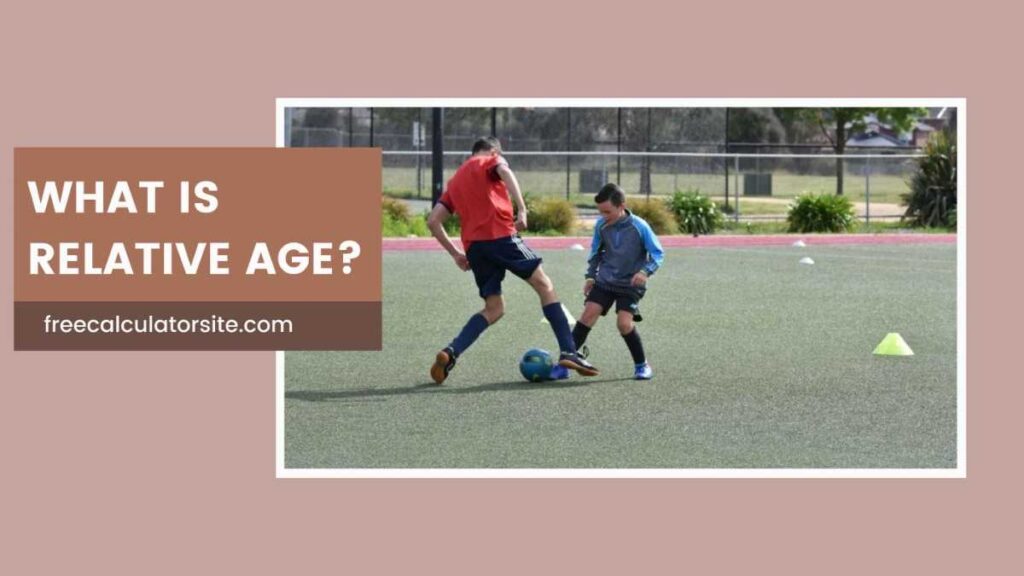Last updated on October 10th, 2024 at 07:27 pm

When you hear the term “age,” your mind might immediately jump to how many birthdays you’ve celebrated or the number of candles on a cake.
However, there’s a different way to measure age that’s not always as straightforward but is just as important—it’s called “relative age.”
Unlike chronological age, which is simply the count of years you’ve been alive, relative age is a concept that helps us understand the differences between individuals or things by comparing them in a specific context.
Let’s dive deeper into what relative age means, how it’s used in various fields, and why it matters more than you might think!
Defining Relative Age
Relative age is a measure that places individuals, objects, or events in an order of occurrence or comparison without necessarily assigning a specific numerical value.
It’s all about understanding where something stands in relation to others, whether it’s older, younger, or the same age.
In simple terms, relative age isn’t about knowing exactly how old something is; instead, it’s about understanding whether one thing is older or younger compared to another.
It’s a bit like comparing apples to oranges and saying, “This apple is riper than that one,” without knowing the exact days since each fruit started ripening.
Relative Age vs. Chronological Age
You might wonder, “Isn’t age just age?” Well, not exactly.
The difference between chronological age and relative age can be compared to reading a calendar versus estimating time.
- Chronological Age: This is the actual number of years, months, and days someone or something has existed. For example, if you’re 25 years old, that’s your chronological age.
- Relative Age: Instead of focusing on the number, relative age is more about comparison. For instance, when comparing two siblings, you might say, “My brother is older than I am,” without specifying the exact age difference.
Relative Age in Different Contexts
1. Education and Development
In schools, children are often grouped according to their chronological age.
However, even within the same age group, children can exhibit vast differences in development, skills, and abilities.
This is where relative age becomes significant.
The “relative age effect” (RAE) is a term used to describe the advantage or disadvantage children experience due to their age in relation to their peers within a specific age group or school year.
For instance, a child born in January might be in the same school year as another child born in December, but because of the nearly one-year age difference, the older child may appear more developed, physically stronger, or more intellectually advanced.
This age gap can impact various aspects, such as:
- Academic Performance: Older students in the same grade tend to perform better academically, as they’ve had more time to develop cognitively.
- Sports and Physical Activities: The relative age effect is even more pronounced in sports, where older children in the same group tend to excel due to being more physically mature.
2. Geology
In geology, relative age is a fundamental concept used to determine the age of rocks and fossils.
Rather than pinpointing an exact age, geologists use relative age to place layers of rock in a sequence from oldest to youngest.
This process, known as “relative dating,” involves principles like:
- Law of Superposition: In an undisturbed sequence of rock layers, the oldest layer is at the bottom, and the youngest is at the top.
- Cross-Cutting Relationships: If one geological feature cuts across another, the feature that has been cut is older.
By comparing rock layers and understanding their relative positions, geologists can piece together Earth’s history and the timeline of various geological events, even without knowing the exact dates.
3. Archaeology
Archaeologists use relative dating to understand the order in which ancient civilizations lived or how different artifacts relate to one another in terms of time.
By examining the stratigraphy (layers of soil and remains), they can determine whether one artifact is older or younger than another, providing insights into the evolution of human societies.
See Also: What is Mental Age?
4. Astronomy
In the vast universe, determining the relative age of stars, planets, and galaxies helps scientists understand cosmic evolution.
By comparing the brightness, color, and composition of stars, astronomers can estimate which stars are older or younger in relation to others.
This, in turn, helps them piece together the story of our galaxy and the universe’s expansion.
Why Does Relative Age Matter?
Understanding relative age has real-world applications across various fields.
Here’s why it’s important:
- In Education: Recognizing the relative age effect helps educators develop fairer assessments and tailor learning experiences. For instance, teachers can identify that younger students in a class might need extra support, ensuring they aren’t unfairly judged against older peers.
- In Sports: Sports organizations increasingly recognize the impact of relative age. For example, some youth leagues now have policies to ensure that younger children aren’t overshadowed by older ones within the same age bracket. This encourages a more inclusive environment where all participants can thrive.
- In Science and History: Understanding the relative age of rocks, fossils, and artifacts allows scientists to reconstruct the past, gaining insights into how life on Earth evolved or how ancient civilizations developed over time.
- In Personal Development: Relative age can also play a role in self-perception and growth. Being aware of how you compare to others in terms of development can help you set realistic goals and understand that growth isn’t always linear.
Interesting Facts About Relative Age
- The “Relative Age Effect” in Professional Sports: Studies have shown that professional athletes, especially in sports like soccer and hockey, are more likely to be born in the earlier months of the year. This relative age advantage gives them a head start in physical development, leading to better performance and greater chances of being scouted early on.
- Relative Age in Leadership: Research has indicated that individuals who are older relative to their peers are more likely to assume leadership roles. This might be due to the early developmental advantages they experience, which build confidence and skills over time.
- Relative Age in Parenting: The concept of relative age doesn’t stop in childhood. Parents often compare their child’s development to others, leading to a sense of pride or concern. Understanding that every child develops at their own pace can help reduce unnecessary stress.
Final Thoughts
Relative age is a fascinating concept that extends beyond simply knowing how many years something or someone has existed.
It’s a comparative tool that provides deeper insights into growth, development, and relationships across various fields.
Whether it’s helping teachers understand their students better, allowing scientists to unlock Earth’s history, or even giving us a broader perspective on our own lives, relative age proves that age is more than just a number—it’s a story of comparison, context, and understanding.
So, the next time you find yourself comparing two things or people, remember that it’s not just about the exact years; it’s about the journey, the experiences, and the context that make up the concept of relative age!

Sayantika Karmakar provides expert insights on financial calculators in her blog posts.
